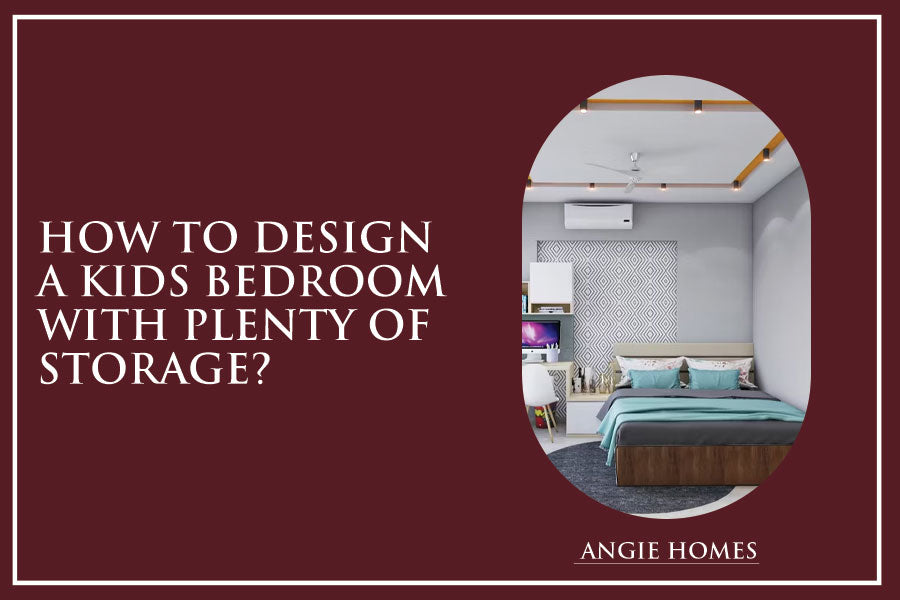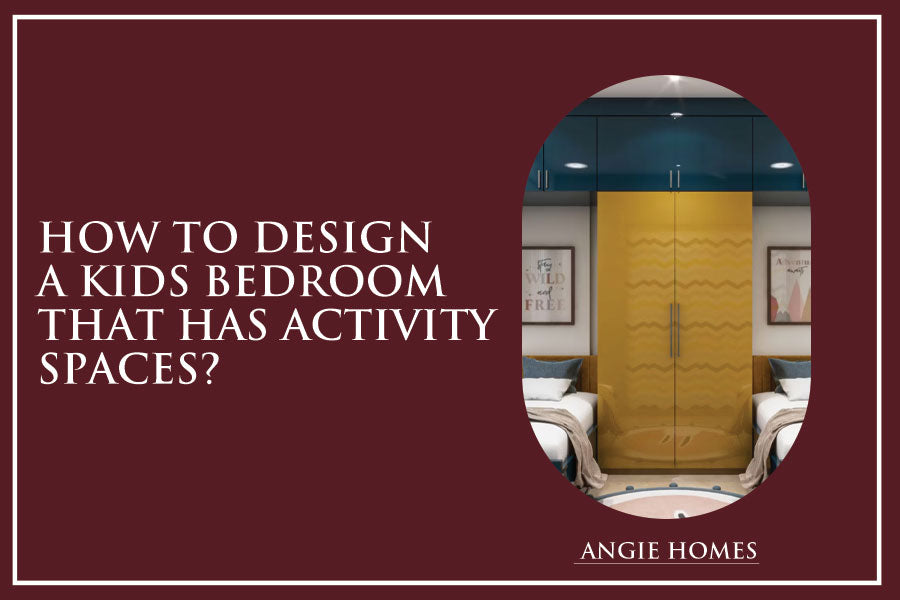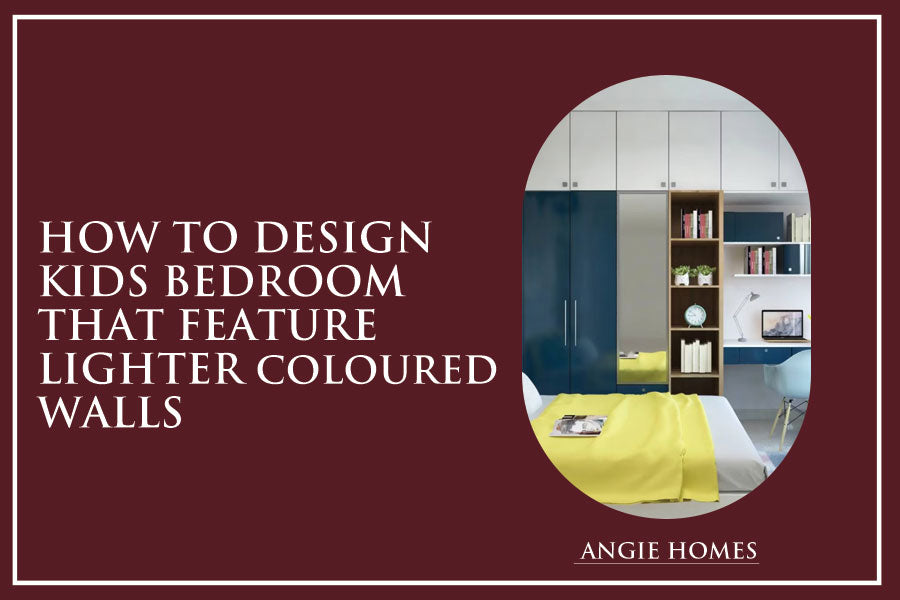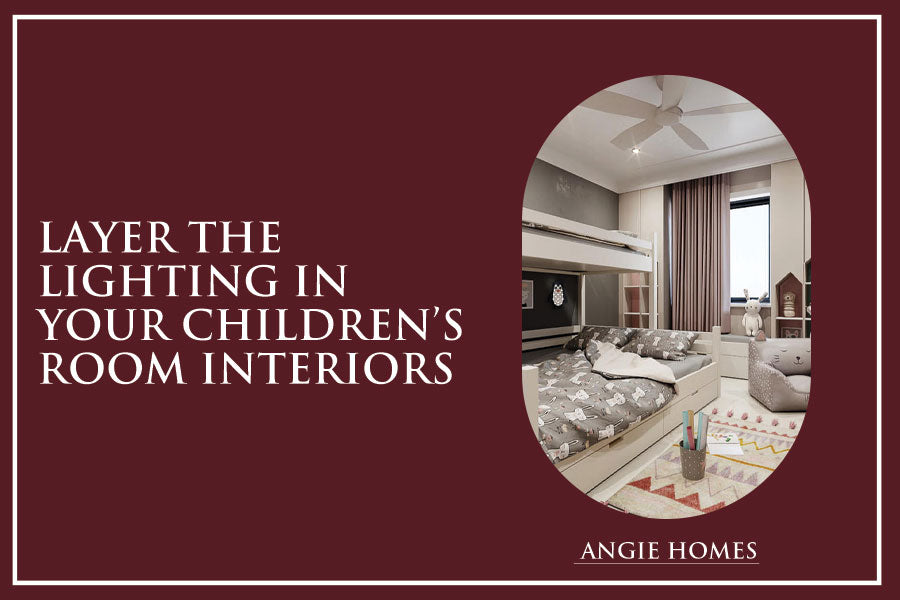Introduction
Figuring out kids' bedroom interior design is a delightful journey that involves balancing functionality, creativity, and the vibrant energy of childhood. A well-designed kids' bedroom goes beyond aesthetics; it nurtures imagination, fosters learning, and provides a haven for restful nights. In this article, we explore various aspects of kids' bedroom interior design, ensuring a harmonious blend of style and functionality.
Create A Multifunctional Space In Your Kids Bedroom

Designing a multifunctional space in your kids' bedroom interior design requires a thoughtful approach to furniture selection and room layout. Opt for versatile pieces that can serve multiple purposes, such as bunk beds with built-in desks or storage units. These kids' bedroom interior design not only maximize floor space but also ensure that the room can adapt to your child's changing needs over time.
Creating zones within the kids' bedroom interior design for different functions adds an extra layer of functionality. A dedicated study corner, a play area with comfortable seating, and a cozy reading nook can coexist harmoniously in a well-designed, multifunctional space. By prioritizing adaptability and versatility in your kids' bedroom interior design, you're not only optimizing the use of space but also providing an environment that can grow with your child, ensuring the room remains relevant and engaging throughout their developmental stages.
How To Design A Kids Bedroom With Plenty Of Storage?

A well-organized kids' bedroom interior design is a testament to thoughtful design, especially when it comes to incorporating ample storage solutions. From toys to clothes and books, children accumulate a variety of belongings that need designated spaces. To achieve this kids' bedroom interior design, consider under-bed drawers, wall-mounted shelves, and vibrant bins that not only serve a practical purpose but also add a playful touch to the decor.
Under-bed storage is a smart solution for utilizing space in your kids' bedroom interior design that is often overlooked. Opt for drawers or bins that slide easily, providing quick access to toys or clothing while keeping the room tidy. Wall-mounted shelves offer a vertical storage solution, making the most of available wall space and preventing the room from feeling cluttered.
Additionally, incorporating vibrant and creative bins or baskets in your kids' bedroom interior design adds an element of fun to the storage system. Encourage your child to participate in organizing their belongings by using colorful containers and labels. This not only instills a sense of responsibility but also makes the process of tidying up an enjoyable activity.
How To Design A Kids Bedroom That Has Activity Spaces?

Designing a kids' bedroom interior design with well-defined activity spaces is essential for fostering creativity, engagement, and a sense of purpose within the room. Creating specific zones for different activities ensures that the space caters to your child's diverse interests and provides dedicated areas for play, study, and relaxation.
Start by establishing a cozy reading nook in your kids' bedroom interior design—a comfortable corner with a bean bag, soft cushions, and good lighting. This designated space encourages a love for reading and provides a retreat for quiet moments. Integrate a well-lit area for arts and crafts, equipped with a sturdy table and storage for art supplies. This ensures that your child has a dedicated space for creative expression and hands-on activities.
The key is to establish a harmonious balance between these activity zones. Thoughtful placement of furniture in your kids' bedroom interior design and clear demarcation of areas help define the purpose of each space. This not only contributes to a more organized environment but also encourages your child to explore different activities in a structured and enjoyable manner.
How To Design Kids Bedroom That Feature Lighter Coloured Walls

Choosing the right wall color is a foundational step in designing a kids' bedroom interior design, and opting for lighter shades can significantly impact the overall atmosphere. Soft pastels or neutral tones create a versatile backdrop that enhances the visual appeal of the space while contributing to a spacious and tranquil ambiance.
Lighter-colored walls have the innate ability to make a room feel more open and airy. This is particularly beneficial in a kids' bedroom interior design, where an expansive and bright environment can positively influence their mood and overall well-being. The subtle tones provide a neutral canvas, allowing for greater flexibility in incorporating vibrant decor elements, furniture, and accessories that reflect your child's personality and interests.
Additionally, the soothing effect of lighter colors promotes a conducive atmosphere for restful sleep. This is especially crucial for a child's well-being and development. By embracing a calming palette in your kids' bedroom interior design, you create a serene environment that supports relaxation and encourages a healthy sleep routine.
Using Artwork As Wall Decor For Kids Bedroom Interior Design

Artwork serves as the soulful expression of a child's personality, transforming kids' bedroom interior design into a personalized haven. When strategically incorporated into the interior design, artwork becomes a powerful tool for creating a visually stimulating and inspiring environment.
Selecting whimsical and age-appropriate pieces in your kids' bedroom interior design that resonate with your child's interests is key. Whether it's colorful prints of animals, beloved characters, or scenes from nature, artwork establishes a thematic cohesion within the room. Consider creating a gallery wall with a mix of framed prints, posters, and even your child's own creations. This not only elevates the aesthetic appeal but also encourages a sense of ownership and pride in their space.
Artwork offers a dynamic and ever-changing aspect to the kids' bedroom interior design, allowing you to update and evolve the decor as your child's tastes and interests develop. Involve them in the selection process, fostering a sense of creativity and self-expression.
How To Design A Kids Bedroom That Infuses Learning Into The Space?

Transforming a kids' bedroom interior design into an educational haven involves intentional design choices that seamlessly integrate learning into the environment. From decor to furniture, every element can contribute to a space that not only nurtures creativity but also facilitates intellectual development.
Begin by incorporating educational posters and wall art. Choose visuals for your kids' bedroom interior design that cover a range of subjects, from letters and numbers to geography and science. These elements not only serve as decorative features but also provide a subtle backdrop for learning. Consider maps, charts, and diagrams that can spark curiosity and serve as conversation starters.
By thoughtfully designing a kids' bedroom interior design that incorporates learning elements, you create an environment that fosters intellectual curiosity and a positive attitude toward education. This holistic approach not only supports academic development but also nurtures a love for learning that can last a lifetime.
How To Design A Kids Bedroom That Personalizes Their Passions?

Personalizing a kids' bedroom involves creating a space that not only reflects their individuality but also celebrates their unique passions and interests. By infusing elements that resonate with their likes and hobbies, you transform the room into a personalized haven that feels truly their own.
Start by identifying your child's interests, whether it's a favorite color, a beloved character, or a particular theme. Incorporate these elements into the decor, bedding, and accessories. For example, if your child loves animals, consider animal-themed bedding, wall decals, and artwork to create a vibrant and personalized atmosphere.
Themed decor, such as superhero or princess motifs, can add a playful touch to the room. Consider incorporating these themes through wall decals, posters, or even furniture with subtle thematic details. This not only adds visual interest but also cultivates a sense of joy and connection to the space.
Layer The Lighting In Your Children’s Room Interiors

Creating a well-lit and inviting atmosphere in your kids' bedroom interior design involves strategic layering of lighting elements. By incorporating a variety of lighting sources, you not only enhance the functionality of the space but also contribute to its aesthetic appeal.
- Overhead Fixtures: Start with overhead fixtures that provide general illumination. Choose playful and age-appropriate designs that add a decorative element to the room. Consider fixtures with adjustable brightness to adapt to different activities and moods.
- Task Lighting: Integrate task lighting for specific areas in your kids' bedroom interior design like study desks or reading nooks. Adjustable desk lamps or wall-mounted fixtures provide focused illumination, creating an optimal environment for homework or reading activities. Ensure the lighting is bright enough to prevent eye strain.
- Ambient Lighting: Include ambient lighting in your kids' bedroom interior design to establish a warm and cozy atmosphere during evening hours. Table lamps or wall sconces with soft, diffused light contribute to a comforting environment, especially during bedtime routines. Consider fixtures with dimming capabilities for flexibility.
- Night Lights: Night lights offer a subtle glow to the kids' bedroom interior design that provides comfort and reassurance during nighttime hours. Opt for whimsical designs that add a touch of charm to the room while ensuring a gentle illumination that doesn't disrupt sleep.
- Decorative Lighting: Consider incorporating decorative lighting elements in your kids' bedroom interior design, such as string lights or themed light fixtures. These not only add a decorative flair but also contribute to the overall theme of the room, enhancing its visual appeal.
How To Design A Kids Bedroom With Curtains And Meshes?

Curtains and meshes play a dual role in a well-designed kids' bedroom interior design—adding aesthetic charm while serving practical functions. Thoughtful selection and placement of curtains and meshes contribute to the overall ambiance and functionality of the space.
- Blackout Curtains: Opt for blackout curtains to regulate natural light in the kids' bedroom interior design and create an optimal sleep environment. These curtains are especially beneficial for ensuring that your child gets restful sleep, free from disturbances caused by external light sources. Choose curtains with playful patterns or colors that complement the room's theme.
- Whimsical Designs: Select curtains with whimsical designs or patterns that resonate with your child's interests. This not only enhances the visual appeal of the room but also adds a personalized touch. Consider themes like nature, animals, or favorite characters to create a cohesive and delightful atmosphere.
- Meshes for Play Areas: Integrate meshes into kids' bedroom interior design to create a playful and imaginative space within the room. Meshes can transform an area into a magical hideaway or define a cozy play corner. Consider installing a mesh canopy above the bed to create a dreamy and enchanting sleep space.
- Durable and Easy-to-Clean Fabrics: Choose curtains and meshes made from durable and easy-to-clean fabrics. The kids' bedroom interior design is prone to spills and messes, and selecting materials that withstand wear and tear ensures longevity. Machine-washable fabrics simplify the maintenance process.
- Adjustable Curtains for Versatility: Opt for curtains with adjustable features, such as tie-backs or curtain rods with multiple hanging options. This allows you to control the amount of natural light entering the room and provides flexibility in changing the room's appearance.
By carefully selecting curtains and meshes, you enhance the functionality of the room while adding a decorative touch. These elements contribute to the overall design theme, whether it's creating a cozy bedtime atmosphere with blackout curtains or transforming a play area with whimsical meshes. Consider both practicality and aesthetics to ensure that curtains and meshes complement the overall interior design, making the kids' bedroom interior design a delightful and functional space.
Conclusion
Designing a kids' bedroom interior design is a delightful journey that involves a harmonious blend of creativity, functionality, and personalization. Each aspect, from creating a multifunctional space to selecting the right curtains, contributes to shaping a space that nurtures growth, learning, and individuality.
In the journey of designing a kids' bedroom interior design, the keyword is balance. Balancing functionality with creativity, personalization with organization, and adaptability with a sense of permanence. The result is a space that not only meets the practical needs of your child but also reflects their personality, fostering a sense of belonging and comfort.
As you embark on the adventure of kids' bedroom interior design, remember that the most successful designs are those that evolve with the child. Stay attuned to their changing interests and needs, and let the room grow alongside them—a dynamic and vibrant backdrop to their childhood journey.
Related Posts :
How To Pair Fabric and Wallpaper : A Comprehensive Guide
Walls That Wow: Enhancing Your Decor with Stylish Wall Sconces
Best Fabrics for Walls : Enhancing Interiors with Style and Texture
How to Cover a Wall With Fabric: Transform Your Space with Angie Homes
Transform Your Space with a DIY Fabric Feature Wall: A Comprehensive Guide
Elegant Walls: A Comprehensive Guide to Fabrics For Wall Decor
The Ultimate Guide to Bedroom Walls: Aesthetic, Decor and Harmony
A Complete Guide to Bedroom Wall Design
Kitchen Design Ideas: Things You Need to Consider
Classic Apartments Interior: Timeless Elegance and Comfort
Modern Apartments Interior Solutions: Elevating Contemporary Living
Harmony in Diversity: Unlocking the World of Fusion Apartments Interior Solutions
Bar Area Interior Solutions: Elevating Spaces with Style and Functionality
Mediterranean Bedroom Design Ideas: Bring the Coastal Vibe Home
Designing the Perfect Home Bar: A Blend of Style and Functionality
An Ultimate Guide to Bedroom Designs
Exploring the World of Kids Bedroom Designs: A Comprehensive Guide
Designing Success: A Comprehensive Guide to Elevating Your Restaurant Interior
30 Restaurant Interior Design Ideas for Creative Inspiration
Dive into the Ultimate Style Guide for Bar Interior Design
Discover the Elegance of Bar Counter Design: Types, Benefits, Advantages and Ideas
7 Innovative Kid’s Chair Design Ideas To Make Study Time Fun
A Guide to Kids Bedroom Styles
Bedroom Furniture Designs To Nurture Your Kids’ Dreams
FAQ's
Q. How to design a children's bedroom?
Ans: Designing a kids' bedroom interior design involves a thoughtful blend of creativity, functionality, and personalization. Start by considering the child's age, interests, and future needs. Create a multifunctional space by choosing adaptable furniture that can evolve with the child. Prioritize storage solutions to maintain organization, and incorporate dedicated zones for various activities like play, study, and relaxation. Choose a color palette that is both soothing and stimulating, and integrate themed decor elements or artwork that reflects the child's interests. Personalize the space with items like bedding, posters, and accessories, and ensure that safety is a top priority in the design.
Q. How to arrange your kids bedroom?
Ans: Arranging a kids' bedroom interior design involves maximizing space and creating a layout that supports their daily activities. Start by placing essential furniture like the bed, study desk, and storage units strategically. Consider traffic flow and leave enough open space for play. Opt for versatile furniture that can adapt to changing needs. Create designated zones for sleep, study, and play, and use rugs or carpets to define these areas. Ensure that the kids' bedroom interior design receives ample natural light, and layer the lighting with a combination of overhead fixtures, task lighting, and decorative lamps. Keep safety in mind by securing heavy furniture to the wall and choosing age-appropriate decor.
Q. What should be in a child's bedroom?
Ans: A kids' bedroom interior design should include essential elements that cater to their physical, emotional, and developmental needs. Start with a comfortable and age-appropriate bed, ensuring it meets safety standards. Integrate ample storage solutions such as dressers, shelves, and bins to maintain organization. Include a study area with a suitable desk and chair to foster good study habits. Decorate with colorful and themed bedding, curtains, and wall art that reflects the child's interests. Add age-appropriate books, toys, and educational materials. Ensure safety by childproofing the room, covering electrical outlets, and securing heavy furniture. Personalize the kids' bedroom interior design with items that hold sentimental value, creating a warm and inviting atmosphere.
Q. How to decorate a small bedroom for a child?
Ans: Decorating a kids' bedroom interior design requires maximizing space and prioritizing functionality. Start by choosing furniture that serves multiple purposes, such as a loft bed with built-in storage or a foldable desk. Use vertical space with wall-mounted shelves and organizers to keep the floor clear. Opt for light-colored walls and mirrors to create an illusion of space and enhance natural light. Choose furniture with a streamlined and compact kids' bedroom interior design to avoid overcrowding. Consider multi-functional decor items like foldable chairs or beds with storage underneath. Use clever storage solutions like under-bed drawers and hanging organizers. Keep the decor simple and cohesive, avoiding clutter. Consider a minimalist approach, focusing on essential elements that reflect the child's personality and interests while maintaining a visually open and organized feel.
